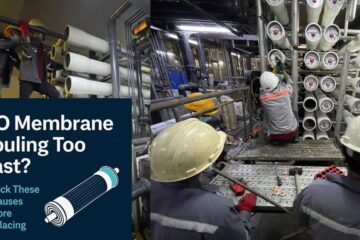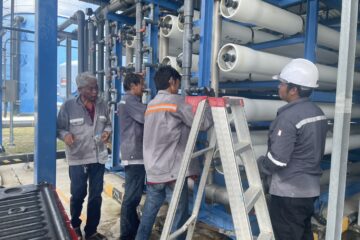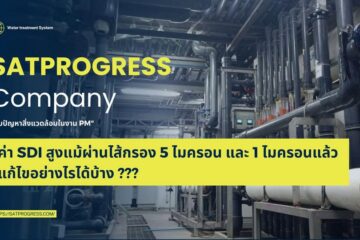Reverse Osmosis (RO) is a highly effective water purification technology widely used to remove contaminants from water. This process is essential in producing clean, potable water and is used in various industries, including desalination, wastewater treatment, food and beverage production, and even in homes for improving drinking water quality.

Understanding the Basics of Reverse Osmosis
At its core, Reverse Osmosis is a process that purifies water by forcing it through a semipermeable membrane. This membrane allows only water molecules to pass through, while blocking a vast majority of impurities, including dissolved salts, organic materials, bacteria, and other contaminants.
The Principle of Osmosis
To understand Reverse Osmosis, it’s helpful first to understand the natural process of osmosis. In osmosis, water naturally moves from an area of low solute concentration (less salty water) to an area of high solute concentration (more salty water) through a semipermeable membrane. This movement continues until equilibrium is reached, meaning both sides of the membrane have equal concentrations of solutes.
How Reverse Osmosis Works
Reverse Osmosis, as the name suggests, reverses this natural process. Here’s how it works:
- Pre-Treatment : Before water undergoes Reverse Osmosis, it must be pre-treated to remove larger particles, chlorine, and other chemicals that could damage the RO membrane. This step often involves filtration and the addition of anti-scalants to prevent scaling on the membrane.
- Pressurization : The water is then pressurized using a pump. This pressure must be greater than the natural osmotic pressure of the water. By applying this pressure, water is forced through the semipermeable membrane.
- Membrane Filtration : As the water is pushed through the membrane, it separates into two streams: the purified water (permeate) and the concentrated brine (reject or concentrate). The membrane allows only water molecules to pass through while retaining the majority of the dissolved salts, organic matter, and other contaminants on the other side.
- Post-Treatment : The purified water may undergo further treatment to adjust its pH, add essential minerals for taste, or ensure it meets specific quality standards before use.
- Concentrate Management : The concentrated brine, containing the rejected contaminants, is typically disposed of or treated further to minimize environmental impact.
Applications of Reverse Osmosis
Reverse Osmosis has a wide range of applications:
- Desalination : RO is the most common method used to convert seawater into fresh, drinkable water, particularly in areas where freshwater is scarce.
- Drinking Water: Many households use RO systems to improve the quality of their drinking water by removing impurities such as lead, fluoride, and other harmful substances.
- Wastewater Treatment : RO is used to treat wastewater by removing contaminants, making the water safe for discharge or reuse.
- Industrial Applications : In industries like food and beverage production, pharmaceuticals, and electronics, RO is used to produce high-purity water essential for various manufacturing processes.
Advantages of Reverse Osmosis
- High Efficiency : RO can remove up to 99% of contaminants, making it one of the most effective water purification methods available.
- Versatility : It can be used for a wide range of applications, from desalination to industrial water treatment.
- Improved Water Quality : RO systems significantly improve the taste, odor, and appearance of water by removing contaminants.
Challenges and Considerations
While RO is highly effective, it also comes with certain challenges:
- Energy Consumption : RO systems require significant energy to pressurize the water and push it through the membrane, which can make the process costly.
- Membrane Fouling : Over time, the RO membrane can become fouled with contaminants, leading to reduced efficiency and the need for regular maintenance.
- Wastewater Production : The process generates a significant amount of wastewater (brine), which must be managed properly to avoid environmental harm.
Conclusion
Reverse Osmosis is a critical technology for providing clean, safe water in a variety of settings. Its ability to remove a wide range of contaminants makes it indispensable in many industries and households. However, understanding its operation, benefits, and challenges is essential for optimizing its use and ensuring the long-term sustainability of water resources.
As RO technology continues to advance, it will likely become even more efficient and accessible, playing a key role in addressing global water challenges.
การกรองแบบ Reverse Osmosis คืออะไรและทำงานอย่างไร?
Reverse Osmosis (RO) คือเทคโนโลยีการกรองน้ำที่มีประสิทธิภาพสูง ซึ่งถูกใช้กันอย่างแพร่หลายในการกำจัดสารปนเปื้อนออกจากน้ำ เทคโนโลยีนี้มีความสำคัญในการผลิตน้ำสะอาดสำหรับการบริโภค และถูกนำไปใช้ในหลากหลายอุตสาหกรรม เช่น การกลั่นน้ำทะเล การบำบัดน้ำเสีย การผลิตอาหารและเครื่องดื่ม และแม้กระทั่งในครัวเรือนเพื่อปรับปรุงคุณภาพน้ำดื่ม
พื้นฐานของการกรองแบบ Reverse Osmosis
หลักการของ Reverse Osmosis นั้นเป็นกระบวนการที่ทำให้น้ำบริสุทธิ์โดยการดันน้ำผ่านเยื่อเมมเบรนชนิดกึ่งซึมผ่านได้ ซึ่งเยื่อเมมเบรนนี้จะยอมให้น้ำโมเลกุลผ่านไปได้เท่านั้น ในขณะที่สารปนเปื้อน เช่น เกลือที่ละลายอยู่ สารอินทรีย์ แบคทีเรีย และสารปนเปื้อนอื่น ๆ จะถูกกักไว้
หลักการของออสโมซิส
เพื่อให้เข้าใจถึง Reverse Osmosis เราควรเข้าใจหลักการธรรมชาติของออสโมซิสเสียก่อน ในกระบวนการออสโมซิส น้ำจะเคลื่อนที่จากบริเวณที่มีความเข้มข้นของสารละลายต่ำ (น้ำที่มีความบริสุทธิ์มากกว่า) ไปยังบริเวณที่มีความเข้มข้นของสารละลายสูง (น้ำที่มีความบริสุทธิ์น้อยกว่า) ผ่านเยื่อเมมเบรนชนิดกึ่งซึมผ่านได้จนกระทั่งความเข้มข้นของสารละลายทั้งสองฝั่งเท่ากัน
การทำงานของ Reverse Osmosis
Reverse Osmosis เป็นกระบวนการที่ทำงานตรงข้ามกับออสโมซิส โดยมีขั้นตอนดังนี้:
- การบำบัดเบื้องต้น (Pre-Treatment): ก่อนที่น้ำจะผ่านกระบวนการ RO จำเป็นต้องผ่านการบำบัดเบื้องต้นเพื่อกำจัดอนุภาคขนาดใหญ่ คลอรีน และสารเคมีอื่น ๆ ที่อาจทำลายเยื่อเมมเบรน กระบวนการนี้มักจะรวมถึงการกรองและการเติมสารป้องกันการเกิดสเกลบนเยื่อเมมเบรน
- การเพิ่มแรงดัน (Pressurization): น้ำจะถูกเพิ่มแรงดันด้วยปั๊ม โดยแรงดันที่ใช้จะต้องมากกว่าความดันออสโมซิสของน้ำ เพื่อดันน้ำผ่านเยื่อเมมเบรน
- การกรองด้วยเยื่อเมมเบรน (Membrane Filtration): เมื่อผ่านเยื่อเมมเบรน น้ำจะแยกออกเป็นสองส่วน คือ น้ำบริสุทธิ์ (permeate) และน้ำเกลือที่มีความเข้มข้นสูง (reject หรือ concentrate) เยื่อเมมเบรนจะยอมให้น้ำโมเลกุลผ่านไปได้เท่านั้น ในขณะที่สารปนเปื้อนส่วนใหญ่จะถูกกักไว้
- การบำบัดหลังกรอง (Post-Treatment): น้ำที่ผ่านการกรองแล้วอาจต้องผ่านการบำบัดเพิ่มเติมเพื่อปรับค่า pH เพิ่มแร่ธาตุเพื่อรสชาติ หรือให้แน่ใจว่าน้ำตรงตามมาตรฐานคุณภาพที่กำหนด
- การจัดการน้ำเกลือ (Concentrate Management): น้ำเกลือที่มีสารปนเปื้อนถูกกักไว้จะต้องถูกจัดการหรือบำบัดเพิ่มเติมเพื่อลดผลกระทบต่อสิ่งแวดล้อม
การใช้งานของ Reverse Osmosis
Reverse Osmosis มีการใช้งานที่หลากหลาย:
- การกลั่นน้ำทะเล (Desalination) : RO เป็นวิธีที่ใช้กันมากที่สุดในการแปลงน้ำทะเลเป็นน้ำดื่มในพื้นที่ที่ขาดแคลนน้ำจืด
- น้ำดื่ม (Drinking Water) : หลายครัวเรือนใช้ระบบ RO เพื่อปรับปรุงคุณภาพน้ำดื่ม โดยการกำจัดสารปนเปื้อน เช่น ตะกั่ว ฟลูออไรด์ และสารที่เป็นอันตรายอื่น ๆ
- การบำบัดน้ำเสีย (Wastewater Treatment) : RO ถูกใช้ในการบำบัดน้ำเสียเพื่อกำจัดสารปนเปื้อน ทำให้น้ำปลอดภัยสำหรับการปล่อยสู่ธรรมชาติหรือการใช้งานใหม่
- อุตสาหกรรมต่าง ๆ (Industrial Applications) : ในอุตสาหกรรมต่าง ๆ เช่น การผลิตอาหารและเครื่องดื่ม ยา และอิเล็กทรอนิกส์ RO ถูกใช้ในการผลิตน้ำบริสุทธิ์สูงที่จำเป็นต่อกระบวนการผลิต
ข้อดีของ Reverse Osmosis
- ประสิทธิภาพสูง: RO สามารถกำจัดสารปนเปื้อนได้ถึง 99% ทำให้เป็นหนึ่งในวิธีการกรองน้ำที่มีประสิทธิภาพมากที่สุด
- ความหลากหลายในการใช้งาน: สามารถใช้ได้ในหลายประเภทของการบำบัดน้ำ ตั้งแต่การกลั่นน้ำทะเลจนถึงการบำบัดน้ำในอุตสาหกรรม
- การปรับปรุงคุณภาพน้ำ: ระบบ RO ช่วยปรับปรุงรสชาติ กลิ่น และลักษณะของน้ำโดยการกำจัดสารปนเปื้อนต่าง ๆ
ข้อควรพิจารณา
แม้ว่า RO จะมีประสิทธิภาพสูง แต่ก็มีข้อเสียประการ
- การใช้พลังงานสูง : ระบบ RO ต้องใช้พลังงานมากในการเพิ่มแรงดันน้ำ ซึ่งอาจทำให้มีต้นทุนการดำเนินงานสูง
- การเกิดฟาวล์ที่เยื่อเมมเบรน : เมื่อเวลาผ่านไป เยื่อเมมเบรนอาจเกิดการอุดตันจากสารปนเปื้อน ซึ่งจะลดประสิทธิภาพและต้องการการบำรุงรักษาเป็นประจำ
- การผลิตน้ำเกลือที่ต้องจัดการ : กระบวนการ RO สร้างน้ำเกลือที่ต้องจัดการหรือบำบัดอย่างถูกต้องเพื่อหลีกเลี่ยงผลกระทบต่อสิ่งแวดล้อม
สรุป
Reverse Osmosis เป็นเทคโนโลยีสำคัญในการผลิตน้ำสะอาดที่มีความปลอดภัยในหลากหลายสถานการณ์ ความสามารถในการกำจัดสารปนเปื้อนต่าง ๆ ทำให้เทคโนโลยีนี้ขาดไม่ได้ในหลายอุตสาหกรรมและครัวเรือน การทำความเข้าใจเกี่ยวกับการทำงาน ข้อดี และความท้าทายของ RO เป็นสิ่งสำคัญในการปรับปรุงการใช้งานและการจัดการทรัพยากรน้ำให้ยั่งยืนในระยะยาว
ขณะที่เทคโนโลยี RO ยังคงพัฒนาอย่างต่อเนื่อง มีแนวโน้มว่าเทคโนโลยีนี้จะมีประสิทธิภาพสูงขึ้นและสามารถเข้าถึงได้มากขึ้น และจะมีบทบาทสำคัญในการแก้ไขปัญหาการขาดแคลนน้ำทั่วโลกในอนาคต
GET IN TOUCH



0 Comments